George Reid (Australian politician)
Sir George Houstoun Reid, GCB, GCMG, KC (25 February 1845 – 12 September 1918) was an Australian politician, Premier of New South Wales and the fourth Prime Minister of Australia.[1]
Reid was the last leader of the Liberal tendency in New South Wales, led by Charles Cowper and Henry Parkes and which Reid organised as the Free Trade and Liberal Association in 1889.[2] He was more effective as Premier of New South Wales from 1894 to 1899 than he was as Prime Minister in 1904 and 1905. This partly reflected the disappearance of the rationale for the Free Trade Party with the imposition of tariffs by the federal government and the disappearance of the political centre ground. Although a supporter of Federation, he took an equivocal position on it during the campaign for the first referendum in June 1898, earning himself the nickname of "Yes-No Reid."
Early life
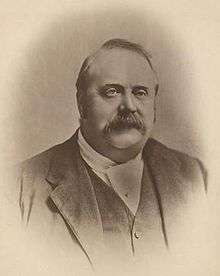
Reid was born in Johnstone, Renfrewshire, Scotland, son of a Church of Scotland minister, and migrated to Victoria with his family in 1852.[2] His family was one of many Presbyterian families brought out from Scotland by Rev Dr John Dunmore Lang, with whom his father worked at Scots' Church, Sydney.[3] He was educated at Scotch College, where he said he could "read, write and count fairly well", but had "a lazy horror of Greek" and no appetite for the "wide range of metaphysical propositions" that formed part of the curriculum.[4]
At the age of 13, Reid and his family moved to Sydney, and he obtained a job as a clerk. At the age of 15 he joined the School of Arts Debating Society, and according to his autobiography, a more crude novice than he had never begun the practise of public speaking.[5] He became an assistant accountant in the Colonial Treasury in 1864 and rose rapidly, becoming head of the Attorney-General's department in 1878.[2] In 1875 he published his Five Essays on Free Trade, which brought him an honorary membership of the Cobden Club, and in 1878 the government published his New South Wales, the Mother Colony of the Australians, for distribution in Europe.[5] In 1876 he began to study law seriously, which would provide the independent income necessary to pursue a parliamentary career (given that parliamentary service was unpaid at the time). In 1879, Reid qualified as a barrister.[4]
Political career
Reid's career was aided by his quick wit and entertaining oratory; he was described as being "perhaps the best platform speaker in the Empire",[6] both amusing and informing his audiences "who flocked to his election meetings as to popular entertainment".[7] In one particular incident his quick wit and affinity for humour were demonstrated when a heckler pointed to his ample paunch and exclaimed "What are you going to call it, George?" to which Reid replied: "If it's a boy, I'll call it after myself. If it's a girl I'll call it Victoria. But if, as I strongly suspect, it's nothing but piss and wind, I'll name it after you."[8] His humour, however, was not universally appreciated. Alfred Deakin detested Reid, describing him as "inordinately vain and resolutely selfish"[8] and their cold relationship would affect both their later careers.
Reid was elected top of the poll to the New South Wales Legislative Assembly as a member for the four-member electoral district of East Sydney in 1880.[9] He was not very active at first, as he was building up his legal practice, although he was concerned to reform the Robertson Land Acts, which had not prevented 96 land holders from controlling eight million acres (32,000 km²) between them. Henry Parkes and John Robertson attempted to make minor amendments to the land acts but were defeated and at the subsequent election Parkes' party lost many seats.
The new premier, Alexander Stuart, offered Reid the position of Colonial Treasurer in January 1883, but he thought it wiser to accept the junior office of Minister for Public Instruction. He served 14 months in this office and succeeded in passing a much improved Education Act, which included the establishment of the first government high schools in the leading towns, technical schools (which became a model for the other colonies)[4] and the provision of evening lectures at the university.[5]
In February 1884, Reid lost his seat in parliament owing to a technicality; the necessary notice had not appeared in the Government Gazette declaring that the Minister for Public Instruction was a position that a parliamentarian could hold without being excluded from parliament for holding an "office of profit" . At the by-election Reid was defeated by a small majority as a result of the government's financial harships due to the loss of revenue from the suspension of land sales. In 1885 he was re-elected in East Sydney and took a great part in the free trade or protection issue. He supported Sir Henry Parkes on the free trade side but, when Parkes came into power in 1887, declined a seat in his ministry. Parkes offered him a portfolio two years later and Reid again refused. He did not like Parkes personally and felt he would be unable to work with him. When payment of members of parliament was passed, Reid, who had always opposed it, paid the amount of his salary into the treasury.[5] Reid had become Sydney's leading barrister by impressing juries by his cross-examinations and was made a Queen's Counsel in 1898.[4]
Premier
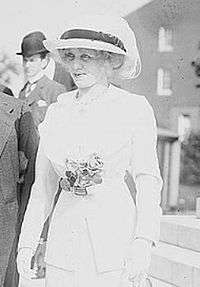
In September 1891, the Parkes ministry was defeated, the Dibbs government succeeded it, and Parkes retired from the leadership of the Free Trade Party. Reid was elected leader of the opposition in his place. In 1891, he married Florence (Flora) Ann Brumby, who was 23 years old to his 46. He managed to form his party into a coherent group although it "ran the whole gamut from conservative Sydney merchants through middle-class intellectuals to reformers who wished to replace indirect by direct taxation for social reasons."[4]
At the 1894 election Reid made the establishment of a real free trade tariff with a system of direct taxation the main item of his policy, and had a great victory. Edmund Barton and other well-known protectionists lost their seats, Labor was reduced from 30 to 18, and Reid formed his first cabinet. One of his earliest measures was a new lands bill which provided for the division of pastoral leases into two halves, one of which was to be open to the free selector, while the pastoral lessee got some security of tenure for the other half. Classification of crown lands according to their value was provided for, and the free selector, or his transferee, had to reside on the property.[5]
At an early stage of the session, Parkes raised the question of federation again, and Reid invited the premiers of the other colonies to meet in conference on 29 January 1895. As a consequence of this conference an improved bill was drafted which ensured that both the people and the parliaments of the various colonies would be consulted. Meanwhile, Reid had great trouble in passing his land and income tax bills. When he did get them through the Assembly the Council threw them out. Reid obtained a dissolution, was victorious at the polls, and heavily defeated Parkes for the new single-member electoral district of Sydney-King. He eventually succeeded in passing his acts, which were moderate, but was strenuously opposed by the Council, and it was only the fear that the chamber might be swamped with new appointments that eventually wore down the opposition. Reid was also successful in bringing in reforms in the keeping of public accounts and in the civil service generally. Other acts dealt with the control of inland waters, and much needed legislation relating to public health, factories, and mining, was also passed.[5] In five years he achieved more than any of his predecessors.[4]
Federation
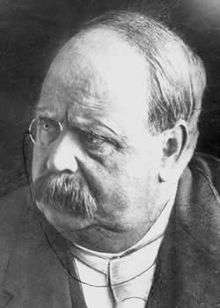
Reid supported the federation of the Australian colonies, but since the campaign was led by his Protectionist opponent Edmund Barton he did not take a leading role. He was dissatisfied by the draft constitution, especially the power of a Senate, elected on the basis of States rather than population, to reject money bills. In the referendum campaign after the close of the Australasian Federal Convention, Reid, on 28 March 1898, made his famous "Yes-No" speech at the Sydney town hall. He told his audience that he intended to deal with the bill "with the deliberate impartiality of a judge addressing a jury". After speaking for an hour and three-quarters the audience was still uncertain about his verdict. He concluded by saying that while he felt he could not become a deserter to the cause he would not recommend any course to the electors. He consistently kept this attitude until the poll was taken on 3 June 1898. This earned him the nickname "Yes-No Reid." The referendum in New South Wales resulted in a small majority in favour, but the yes votes fell about 8000 short of the required 80,000.[5] Subsequently Reid was able to secure greater concessions for New South Wales.
At the general election held soon after, Barton accepted Reid's challenge to contest the East Sydney seat. Reid defeated him, but his party came back with a reduced majority. Reid fought for federation at the second referendum and it was carried in New South Wales by a majority of nearly 25,000, with 107,420 votes being cast in favour of it. "A bizarre combination of the Labor Party, protectionists, Federation enthusiasts and die-hard anti-Federation free traders" censured Reid for paying the expenses of J. C. Neild who had been commissioned to report on old-age pensions, prior to parliamentary approval. Governor Beauchamp refused Reid a dissolution and he resigned.[4] By this time Reid had grown extremely overweight and sported a walrus moustache and a monocle, but his buffoonish image concealed a shrewd political brain.
Federal politics
Reid was elected to the first federal Parliament as the Member for East Sydney at the 1901 election. The Free Trade Party won 28 out of 75 seats in the House of Representatives, and 17 out of 36 seats in the Senate. Labour no longer trusted Reid and gave their support to the Edmund Barton Protectionist Party government, so Reid became the first Leader of the Opposition, a position well-suited to his robust debating style and rollicking sense of humour. In the long tariff debate Reid was at a disadvantage as parliament was sitting in Melbourne and he could not entirely neglect his practice as a barrister in Sydney, as his parliamentary income was less than a tenth of his income from his legal practice. With the rise of the Labour Party, the Free Trade Party had lost much of the middle ground to Barton and his followers, and it was increasingly dependent on conservatives, including militant Protestants.[4][5]
On 18 August 1903, Reid resigned (the first member of the House of Representatives to do so) and challenged the government to oppose his re-election on the issue of its refusal to accept a system of equal electoral districts.[4] He contested the by-election for East Sydney on 4 September, and won it back.[10] He is the only person in Australian federal parliamentary history to win back his seat at a by-election triggered by his own resignation.
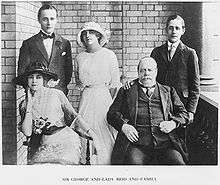
Alfred Deakin took over from Barton as Prime Minister and leader of the Protectionists. At the 1903 election, the Free Trade Party won 24 seats, with the Labour vote increasing mainly at the expense of the Protectionists. In August 1904, when the Watson government resigned, Reid became Prime Minister. He was the first former state premier to become Prime Minister (the only other to date being Joseph Lyons). Reid did not have a majority in either House, and he knew it would be only a matter of time before the Protectionists patched up their differences with Labour, so he enjoyed himself in office while he could. In July 1905 the other two parties duly voted him out, and he left office with good grace.
Reid adopted a strategy of trying to reorient the party system along Labour vs non-Labour lines – prior to the 1906 election, he renamed his Free Trade Party to the Anti-Socialist Party. Reid envisaged a spectrum running from socialist to anti-socialist, with the Protectionist Party in the middle. This attempt struck a chord with politicians who were steeped in the Westminster tradition and regarded a two-party system as very much the norm.[11]
The Protectionist vote and seat count dropped again at the 1906 election, while both Reid's party and Labour won 26 seats each. He also referred to Labour publicly using a damaging visual negative image of Labour as a hungry socialist tiger that would devour all.[12] The Deakin government continued with Labour support for the time being, despite only holding 16 seats after losing 10, although with another 5 independent Protectionists.
In 1907–08, Reid strenuously resisted Deakin's commitment to increase tariff rates. When Deakin proposed the Commonwealth Liberal Party, a "Fusion" of the two non-Labour parties, Reid resigned as party leader on 16 November 1908. The following day, Joseph Cook was made leader until the parties merged.[13]
On 24 December 1909 Reid resigned from Parliament (he was the first Member to have resigned twice), however his seat was left vacant until the 1910 election. His seat of East Sydney was won by Labour's John West, in an election which saw Labour win 42 of 75 seats, against the CLP on 31 seats. Labour also won a majority in the Senate.
Later life and legacy
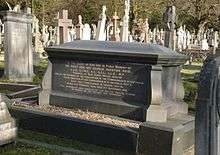
In 1910, Reid was appointed as Australia's first High Commissioner in London.[4]
Reid was extremely popular in Britain, and in 1916, when his term as High Commissioner ended, he was elected unopposed to the House of Commons for the seat of St George, Hanover Square as a Unionist candidate, where he acted as a spokesman for the self-governing Dominions in supporting the war effort. He died suddenly in London on 12 September 1918,[14][15] aged 73, of cerebral thrombosis, survived by his wife and their two sons and daughter.[4] She had become Dame Flora Reid GBE in 1917. He is buried in Putney Vale Cemetery.
Reid's posthumous reputation suffered from the general acceptance of protectionist policies by other parties, as well as from his buffoonish public image. In 1989 W. G. McMinn published George Reid (Melbourne University Press), a serious biography designed to rescue Reid from his reputation as a clownish reactionary and attempt to show his Free Trade policies as having been vindicated by history.
Honours
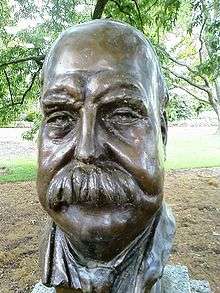
In 1897 Reid was made an Honorary Doctor of Civil Law (DCL) by Oxford University. Reid was also appointed a member of Her Majesty's Most Honourable Privy Council (1904), a Knight Grand Cross of the Order of St Michael and St George (1911) and a Knight Grand Cross of the Order of the Bath (1916).[4]
In 1969 he was honoured on a postage stamp bearing his portrait issued by Australia Post.[16]
Works
See also
Sources
- ↑ "Prime Facts 19" (PDF). Old Parliament House. The Australian Prime Ministers Centre. Retrieved 8 January 2008.
- 1 2 3 "George Reid". Prime Ministers. National Archives of Australia. Retrieved 4 May 2007.
- ↑ Baker, D.W.A. (1998). Preacher, Politician, Patriot: A Life Of John Dunmore Lang. Carlton, Victoria: Melbourne University Press.
- 1 2 3 4 5 6 7 8 9 10 11 12 McMinn, W. G. (2006), "Reid, Sir George Houstoun (1845–1918)", Australian Dictionary of Biography (Online ed.), Australian National University, retrieved 9 April 2009
- 1 2 3 4 5 6 7 8 Serle, Percival. "Reid, Sir George Houstoun (1845–1918)". Dictionary of Australian Biography. Project Gutenberg Australia. Retrieved 4 May 2007.
- ↑ McGinn, W.G (1989). George Reid. Melbourne University Press, Melbourne. ISBN 0-522-84373-5.
- ↑ Abjorensen, Norman. George Reid, The Democrat as Equivocator: Piss and Wind, or Principles in Search of a Constituency?.
- 1 2 Grattan, Michelle (2000). Australian Prime Ministers. New Holland Publishers (Australia) Pty Ltd. ISBN 1-86436-756-3.
- ↑ "Sir George Houston Reid (1845–1918)". Members of Parliament. Parliament of New South Wales. Retrieved 4 May 2007.
- ↑ "House of Representatives by-elections 1901–2008" (PDF). Parliament of Australia. p. 18. Retrieved 8 February 2010.
- ↑ Fusion: The Party System We Had To Have? – by Charles Richardson CIS 25 January 2009
- ↑ Julian Fitzgerald On Message: Political Communications of Australian Prime Ministers 1901–2014 Clareville Press 2014, p 64
- ↑ Leader of the Opposition: Parliamentary Education Office
- ↑ "SIR GEORGE REID'S DEATH.". The Sydney Morning Herald. National Library of Australia. 17 September 1918. p. 8. Retrieved 31 October 2014.
- ↑ "Fast facts: George Reid". Australia's Prime Ministers. National Archives of Australia. Retrieved 31 October 2014.
- ↑ Stamp
Further reading
- Hughes, Colin A (1976), Mr Prime Minister. Australian Prime Ministers 1901–1972, Oxford University Press, Melbourne, Victoria, Ch.5. ISBN 0-19-550471-2
- Grattan, Michelle (2000), Australian prime ministers, New Holland, ISBN 978-1-86436-671-6
External links
| Wikimedia Commons has media related to George Houstoun Reid. |
| Wikisource has the text of a 1922 Encyclopædia Britannica article about George Reid. |
- Archival records and sources held at the National Archives of Australia
- Audio lecture on the life of George Reid, National Museum of Australia
- Undated photo of George Reid and Mrs. Oliver T. Johnston from Library of Congress collection
- George Reid at Find a Grave
